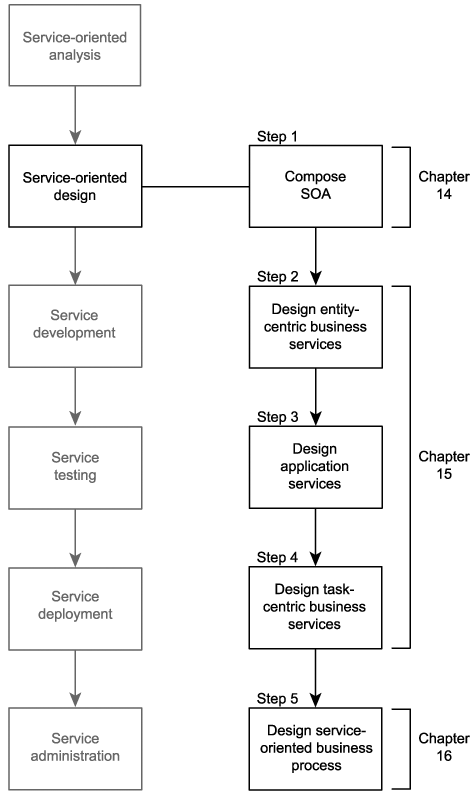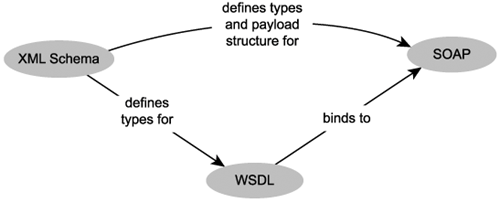Introduction to service-oriented design
Service-oriented design is the process by which concrete physical service designs are derived from logical service candidates and then assembled into abstract compositions that implement a business process.
13.1.1. Objectives of service-oriented design
The primary questions answered by this phase are:
- How can physical service interface definitions be derived from the service candidates modeled during the service-oriented analysis phase?
- What SOA characteristics do we want to realize and support?
- What industry standards and extensions will be required by our SOA to implement the planned service designs and SOA characteristics?
To address these questions, the design process actually involves further analysis. This time our focus is on environmental factors and design standards that will shape our services.
The overall goals of performing a service-oriented design are as follows:
- Determine the core set of architectural extensions.
- Set the boundaries of the architecture.
- Identify required design standards.
- Define abstract service interface designs.
- Identify potential service compositions.
- Assess support for service-orientation principles.
- Explore support for characteristics of contemporary SOA.
13.1.2. "Design standards" versus "Industry standards"
The term "standards" is used frequently in this chapter. It is easy to confuse its context, so we often qualify it. Design standards represent custom standards created by an organization to ensure that services and SOAs are built according to a set of consistent conventions. Industry standards are provided by standards organizations and are published in Web services and XML specifications (as explained in the "Standards" vs. "Specifications" vs. "Extensions" section of Chapter 4).
13.1.3. The service-oriented design process
As with the service-oriented analysis, we first establish a parent process that begins with some preparatory work. This leads to a series of iterative processes that govern the creation of different types of service designs and, ultimately, the design of the overall solution workflow (Figure 13.1).
Figure 13.1. A high-level service-oriented design process.

Step 1: Compose SOA
A fundamental quality of SOA is that each instance of a service-oriented architecture is uniquely composable. Although most SOAs will implement a common set of shared technologies based on key XML and first-generation Web services specifications, the modular nature of the WS-* specification landscape allows for extensions to this core architecture to be added as required.
This step consists of the following three further steps that are explained in Chapter 14:
|
1. |
Choose service layers. |
|
2. |
Position core SOA standards. |
|
3. |
Choose SOA extensions. |
Steps 2 to 4: Design services
These steps are represented by the following three separate processes provided in Chapter 15:
- Entity-centric business service design process.
- Application service design process.
- Task-centric business service design process.
Our primary input for each of these service design processes is the corresponding service candidates we produced in the service modeling process during the service-oriented analysis.
Step 5: Design service-oriented business process
Upon establishing an inventory of service designs, we proceed to create our orchestration layerthe glue that binds our services with business process logic. This step results in the formal, executable definition of workflow logic, which translates into the creation of a WS-BPEL process definition (as explained in Chapter 16).
13.1.4. Prerequisites
Before we get into the details of the service-oriented design process, we should make sure that we have a sufficient understanding of key parts of the languages required to design services.
In Chapter 5 we described concepts related to WSDL and SOAP. In the next few sections, we supply introductory descriptions of the primary elements provided by these two markup languages, in addition to a handful of key elements from the XML Schema Definition Language. (Figure 13.2 re-establishes how these three specifications relate to each other.)
Figure 13.2. Three core specifications associated with service design.

These introductions are by no means a substitute for proper tutorials. The purpose of these sections is to provide you with enough background information so that you can better understand the following parts of the service-oriented design chapters:
- The references made to specific parts of a language in the upcoming SOA Composition Guidelines chapter and the service design process descriptions in Chapter 15.
- The markup code samples provided in the many case study examples interspersed throughout the three service design process descriptions in Chapter 15.
Note
If you already are comfortable with WSDL, SOAP, and XML Schema, feel free to skip ahead to the next chapter.
|
SUMMARY OF KEY POINTS |
|---|
|
Introduction
- Why this book is important
- Objectives of this book
- Who this book is for
- What this book does not cover
- How this book is organized
- Additional information
Case Studies
- Case Studies
- How case studies are used
- Case #1 background: RailCo Ltd.
- Case #2 background: Transit Line Systems Inc.
Part I: SOA and Web Services Fundamentals
Introducing SOA
- Introducing SOA
- Fundamental SOA
- Common characteristics of contemporary SOA
- Common misperceptions about SOA
- Common tangible benefits of SOA
- Common pitfalls of adopting SOA
The Evolution of SOA
- The Evolution of SOA
- An SOA timeline (from XML to Web services to SOA)
- The continuing evolution of SOA (standards organizations and contributing vendors)
- The roots of SOA (comparing SOA to past architectures)
Web Services and Primitive SOA
- Web Services and Primitive SOA
- The Web services framework
- Services (as Web services)
- Service descriptions (with WSDL)
- Messaging (with SOAP)
Part II: SOA and WS-* Extensions
Web Services and Contemporary SOA (Part I: Activity Management and Composition)
- Web Services and Contemporary SOA (Part I: Activity Management and Composition)
- Message exchange patterns
- Service activity
- Coordination
- Atomic transactions
- Business activities
- Orchestration
- Choreography
Web Services and Contemporary SOA (Part II: Advanced Messaging, Metadata, and Security)
- Web Services and Contemporary SOA (Part II: Advanced Messaging, Metadata, and Security)
- Addressing
- Reliable messaging
- Correlation
- Policies
- Metadata exchange
- Security
- Notification and eventing
Part III: SOA and Service-Orientation
Principles of Service-Orientation
- Principles of Service-Orientation
- Service-orientation and the enterprise
- Anatomy of a service-oriented architecture
- Common principles of service-orientation
- How service-orientation principles inter-relate
- Service-orientation and object-orientation (Part II)
- Native Web service support for service-orientation principles
Service Layers
- Service Layers
- Service-orientation and contemporary SOA
- Service layer abstraction
- Application service layer
- Business service layer
- Orchestration service layer
- Agnostic services
- Service layer configuration scenarios
Part IV: Building SOA (Planning and Analysis)
SOA Delivery Strategies
- SOA Delivery Strategies
- SOA delivery lifecycle phases
- The top-down strategy
- The bottom-up strategy
- The agile strategy
Service-Oriented Analysis (Part I: Introduction)
- Service-Oriented Analysis (Part I: Introduction)
- Service-oriented architecture vs. Service-oriented environment
- Introduction to service-oriented analysis
- Benefits of a business-centric SOA
- Deriving business services
Service-Oriented Analysis (Part II: Service Modeling)
- Service-Oriented Analysis (Part II: Service Modeling)
- Service modeling (a step-by-step process)
- Service modeling guidelines
- Classifying service model logic
- Contrasting service modeling approaches (an example)
Part V: Building SOA (Technology and Design)
Service-Oriented Design (Part I: Introduction)
- Service-Oriented Design (Part I: Introduction)
- Introduction to service-oriented design
- WSDL-related XML Schema language basics
- WSDL language basics
- SOAP language basics
- Service interface design tools
Service-Oriented Design (Part II: SOA Composition Guidelines)
- Service-Oriented Design (Part II: SOA Composition Guidelines)
- Steps to composing SOA
- Considerations for choosing service layers
- Considerations for positioning core SOA standards
- Considerations for choosing SOA extensions
Service-Oriented Design (Part III: Service Design)
- Service-Oriented Design (Part III: Service Design)
- Service design overview
- Entity-centric business service design (a step-by-step process)
- Application service design (a step-by-step process)
- Task-centric business service design (a step-by-step process)
- Service design guidelines
Service-Oriented Design (Part IV: Business Process Design)
- Service-Oriented Design (Part IV: Business Process Design)
- WS-BPEL language basics
- WS-Coordination overview
- Service-oriented business process design (a step-by-step process)
Fundamental WS-* Extensions
- Fundamental WS-* Extensions
- You mustUnderstand this
- WS-Addressing language basics
- WS-ReliableMessaging language basics
- WS-Policy language basics
- WS-MetadataExchange language basics
- WS-Security language basics
SOA Platforms
Appendix A. Case Studies: Conclusion
EAN: 2147483647
Pages: 150
